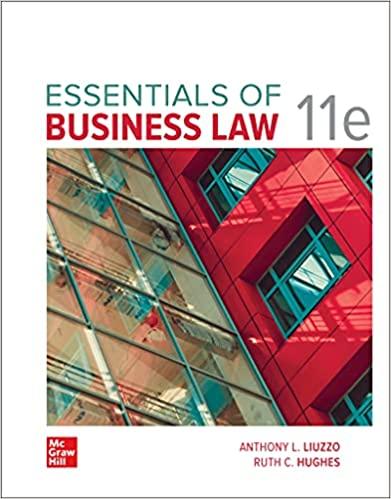Question
Employment Law 1. What is the purpose of each of the following worker protection statutes?What are its basic provisions? a.Fair Labor Standards Act b.Family and
Employment Law
1.What is the purpose of each of the following worker protection statutes?What are its basic provisions?
a.Fair Labor Standards Act
b.Family and Medical Leave Act
c.OSHA
d.Workers' Compensation and Unemployment Compensation
e.Social Security and Medicare
f.ERISA and COBRA
Equal Employment Opportunity Law
1.What is prohibited employment discrimination?Constructive discharge?Retaliation?
2.What agency enforces federal EEO law?What is the process for filing an EEO lawsuit?When must it be filed?
3.What are the three legal theories used to determine if an employer illegally discriminated against an employee under Title VII?What are the elements of each?When is it appropriate to use each?
4.What are the defenses available to an employer?What remedies are available to a successful plaintiff in an EEO case?
5.What are the basic provisions and who is covered by each of the following EEO laws?Be familiar with differences in number of employees required for statute to apply, as well as any changes in legal theories used to determine violations.
a.Title VII and its five protected classes
b.Equal Pay Act
c.Pregnancy Discrimination Act of 1978 (amending Title VII)
d.Age Discrimination in Employment Act
e.Americans with Disabilities Act and 2008 Amendments
f.Genetic Information and Nondisclosure Act
6.How does the EEOC define sexual harassment?
a.What do the courts mean by "quid pro quo" and "hostile environment" harassment?
b.What is the Faragher-Ellerth standard and how is it used to determine an employer's liability for harassment of an employee by a supervisor?By a co-worker or customer?
c.Do these standards apply to harassment based on race, age, disability and other protected categories?
7.Title VII requires reasonable accommodation of an employee's religious beliefs if doing so does not impose an undue hardship or burden, while ADA requires reasonable accommodation of an otherwise qualified employee's disability unless doing so imposes an undue hardship or burden on the employer.What does this legal standard mean and how does it apply?
Step by Step Solution
There are 3 Steps involved in it
Step: 1

Get Instant Access to Expert-Tailored Solutions
See step-by-step solutions with expert insights and AI powered tools for academic success
Step: 2

Step: 3

Ace Your Homework with AI
Get the answers you need in no time with our AI-driven, step-by-step assistance
Get Started


